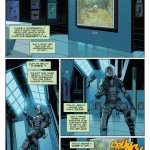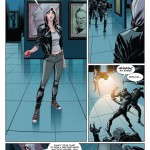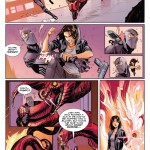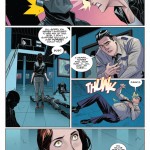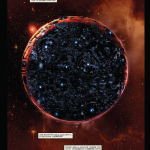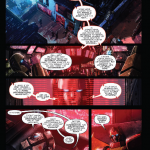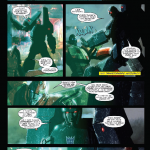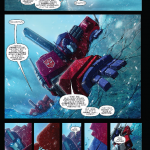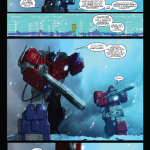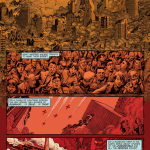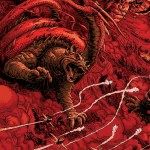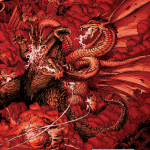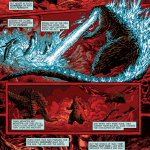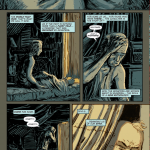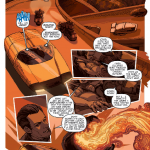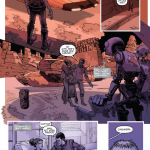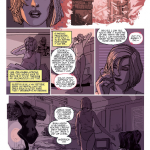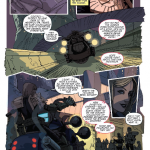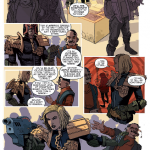It’s Wednesday and that means new comics. Let Deadshirt steer your wallet in the right direction with reviews (with preview pages) of titles out today from Image, Dark Horse, IDW, BOOM! Studios, MonkeyBrain, Oni, Fantagraphics, Top Shelf, Action Lab, and more!
Hexed #1
Written by Michael Alan Nelson
Illustrated by Dan Mora
Colors by Gabriel Cassata
Lettered by Ed Dukeshire
BOOM! Studios
$3.99
Michael Alan Nelson is back with the comic he conjured up five years ago. Hexed follows the story of Lucifer, a very likable and, despite the name, not-evil heroine who just happens to make a living as a professional thief-for-hire. After a simple museum heist goes wrong, Lucifer has to deal with compounding problems from new and old players in a dangerous scenario that escalates with a major sacrifice. Readers don’t necessarily need to be familiar with the previous run as this first issue does a good job filling in the details.
Despite dealing with some heavy stuff, Hexed is lively. Gabriel Cassata’s colors make for some beautiful graphic violence, and Dan Mora’s exaggerated perspectives amp up the power when Lucifer throws a punch. The hues and shading change with each scene and give a solid sense of space, especially when the scene changes into an alternate dimension (which happens more often than one would expect). It’s surprising how well the bright pinks and reds frame a story about dark magic, but by the end I wouldn’t have it any other way.
Readers like myself will enjoy the fact that Hexed gives off a major Buffy the Vampire Slayer vibe. Lucifer’s banter, like Buffy’s, bridges the gap between the normal and the paranormal. She faces enemies with wit and sarcasm but acts as the someone’s-gotta-do-it hero when things get serious. And they get serious rather quickly. Along with a strong heroine, this comic delivers a fresh take on magic as well as pretty creepy surprises (eyeball bouquet, anyone?). This first issue constantly hits you over the head with the theme of cost; there’s a price for everything, especially magic, and Lucifer has very little time to decide what kind of hero to be. The last page leaves you with a blatant cliffhanger, so readers should plan on a full commitment.
– Sarah Register
(Click thumbnails to enlarge)
The Transformers: Primacy #1
Written by Chris Metzen and Flint Dille
Art by Livio Ramondelli
Lettered by Chris Mowry
IDW Publishing
$3.99
Primacy is the third of a trilogy of miniseries co-written by G1 animation scribe Flint Dille that tell the story of the early days of the Great War. They are all illustrated in spectacular fashion by Livio Ramondelli’s painting-like panels. It’s a very “love-it-or-hate-it” series, loved for more “classic” storylines than the current line of Transformers comics and some intriguing continuity points, but hated for some inconsistencies, some iffy layouts and proportions, and a general sort of been-there-done-that feeling.
Primacy #1 is more of the same in all departments. A couple of great conflicts are set up, with the Decepticons unexpectedly fleeing the planet, Megatron accidentally resurrecting his twisted mentor Pentius, and dissension in the Autobot ranks. But some of Omega Supreme’s dialogue is difficult to reconcile with his previously-established backstory. New readers would be well-served starting from the first trilogy, Autocracy, as this issue relies heavily on established story points. Old readers should only come in if they enjoyed Autocracy and Monstrosity (fortunately I did).
– Patrick Stinson
(Click thumbnails to enlarge)
Godzilla: Cataclysm #1
Written by Cullen Bunn
Art by Dave Wachter
Lettered by Chris Mowry (also a creative consultant)
IDW
$3.99
Cataclysm explores some themes that IDW’s Godzilla has touched on in Kingdom of Monsters and Half-Century War, specifically the idea that kaiju are an existential threat to society. In this book, humanity failed to hold the line and only old men and women remember civilization, with most others revering the kaiju as gods. Supposedly the kaiju have all disappeared too, but we know that won’t last.
It is the conceits of the comics approach that I suspect are holding this story back from its true potential. The post-apocalyptic world is explained partly in dialogue instead of all in “voice-over” panels, a laudable idea crippled by the fact that they’ve all grown up in this village and none of the customs need to be explained to anyone. The slow build that’s suggested by the beginning of the story is thrown out the window in the last panels when Godzilla show up. (I strongly suspect that Toho mandates that he appear in every issue.) We also don’t get quite enough panel time with the various similar-looking characters to sympathize with them before they start getting knocked off.
The triumph of this issue is how artist Dave Wachter makes the Kamacuras, a joke villain from 1967, into a terrifying Aliens-esque threat. They move literally too fast for the human eye through an endless urban jungle, leaving only bleeding, booted feet behind. There is also a gorgeous flashback splash panel of Godzilla, King Ghidorah, Manda, and Anguirus tussling over a red, ruined city that viscerally makes you feel that they’ve crushed it all and it’s all gone. I hope that writer Cullen Bunn keeps developing this world with full creative freedom. We’ve seen the peaceful village and the ruined city, now it’s time to get the refugees into some serious Mad Max shenanigans, and throw in some Lovecraftian-style kaiju cults!
– Patrick Stinson
(Click thumbnails to enlarge)
Zero #10
Written by Ales Kot
Art by Michael Gaydos and Jordie Bellaire (colors)
Lettered by Clayton Cowles
Image
$2.99
With Zero, writer Ales Kot is definitely playing the long game. I wasn’t really sure how I felt about this book until issue #5, when Kot changed his own game. Since then I’ve been hooked—Kot has my trust. For any unfamiliar with the series, Zero is illustrated by a different artist every issue. While this could seem like a gimmick, the story is being narrated by the character Edward Zero (to a boy holding a gun to his head) and so each chapter is a glimpse of the past and the different visual styles remind the reader of this larger frame. The book tends to feel slightly different with every issue, and this one is no exception.
Issue #10 is quiet; the first page is followed by eight of complete silence. This is extremely effective coming after the rollercoaster of the issues preceding it. It’s a tonal shift that is surprising, given what the series has been, but also makes complete sense. In nine issues Zero built up a world and broke it down to an issue dealing with trauma and guilt and questions of identity. This issue is intelligently set in a cold Icelandic winter, allowing the thick, heavy art and muted color to match the mental state of Edward, with occasional punctuations of anguish.
The end of this issue left me with a lot of questions, and I haven’t been able to stop thinking about it. I’ll think I understand, and then I re-read the last few pages and I’m not sure. This is why I keep coming back to Zero, it gets in my head and makes a home for itself. It’s murky. If you’re already reading this comic you don’t need me to tell you to buy it. If you’re not, all I can say is that Zero is evolving in a way that takes risks a lot of stories, comics or otherwise, don’t. And it’s just getting started.
– Daniel Poirier
Judge Dredd: Anderson, Psi-Division #1
Written by Matt Smith
Art by Carl Critchlow
Letters by Shawn Lee
IDW
$3.99
Judge Anderson has long been one of the star supporting players in 2000 AD’s long-running Judge Dredd strip, eventually earning her own series of strips in both 2000 AD’s weekly series and in the monthly Megazine. Now she’s scored her own mini-series in IDW’s Judge Dredd line. Awakened from sleep, Anderson catches a precognitive flash of a robbery at Megapolitan Museum of Modern History and after alerting her fellow judges, goes along to see if she can suss out more about what’s going to happen. Her instincts prove to be right and she’s soon following the thieves to the massive atomic swamp that used to be Alabama, partnered with Texas City, America’s southern Mega-City.
IDW’s been doing a great job with making these new series good entry points for Judge Dredd and his gigantic cast. Over 35 years of consistent continuity (where all of the characters have been progressing in real time) can seem incredibly daunting even to comics readers used to big two superhero universes, but these series (and 2000 AD itself) are easy to pick up and just go, even if you’re only familiar with the characters from the recent movie. This mini-series gives some brief insight into Anderson’s backstory (with the promise of some revelations to come) but also provides a fast-moving story that sucks you in. It’s also cool that it gets out of the usual digs of Mega-City One and into Texas City and the Alabama Morass. It greatly expands the scope of the series while also putting the characters into a setting that’s underexplored, so it’s new for both new readers and old.
The art by Carl Critchlow isn’t flashy, but it definitely has mixture of Carlos Ezquerra and Cameron Stewart vibe to it that is really pleasing on the eye. He’s especially good at contrasting the Judges’ big, blocky outfits with the smaller bodies of the lady Judges at the center of this comic. Moving through two Mega-Cities and the giant swamp, Critchlow gets a lot to draw in the background in this single issue and he does a great job in making each location shine on its own.
– Jason Urbanciz
(Click thumbnails to enlarge)
Be sure to let us know what you picked up this week in the comments below, on Twitter or on our Facebook Page!


